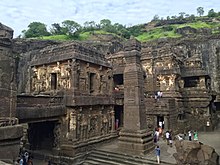
Rock-cut architecture is the creation of structures, buildings, and sculptures by excavating solid rock where it naturally occurs. Intensely laborious when using ancient tools and methods, rock-cut architecture was presumably combined with quarrying the rock for use elsewhere. In India and China, the terms cave and cavern are often applied to this form of man-made architecture, but caves and caverns that began in natural form are not considered to be rock-cut architecture even if extensively modified.[1] Although rock-cut structures differ from traditionally built structures in many ways, many rock-cut structures are made to replicate the facade or interior of traditional architectural forms. Interiors were usually carved out by starting at the roof of the planned space and then working downward. This technique prevents stones falling on workers below. The three main uses of rock-cut architecture were temples (like those in India), tombs, and cave dwellings (like those in Cappadocia).
A related term, monolithic architecture, refers to free-standing structures made of a single piece of material. Monolithic architecture is often rock-cut, as in the Ellora Kailasanathar Temple, but monolithic structures may also be cast of artificial material, such as concrete. The largest monolithic statue in the world, the Gommateshwara statue of Bahubali at Shravanabelagola in the Indian state of Karnataka, was carved in 983 CE from a single block of granite.[2][3]

Some rock-cut architecture is excavated entirely in chambers under the surface of relatively level rock. This is especially common in rock-cut tombs. Excavations instead made into the side of a cliff or steep slope can feature an impressive facade, as in Lycian tombs, Petra, and the Ajanta Caves. The most laborious and imposing rock-cut architecture is the excavation of tall free-standing monolithic structures entirely below the surface level of the surrounding rock, in a large excavated hole around the structure. Ellora in India and the Zagwe-built Lalibela in Ethiopia provide some of the most famous examples of such structures. Many parts of the world feature rock reliefs, relief sculptures carved into rock faces, often outside caves.

- ^ Francis Ching, Mark Jarzombek, Vikramaditya Prakash, A Global History of Architecture (Wiley, 2006)
- ^ Statue of Gomateswara
- ^ World's biggest monolithic Statue